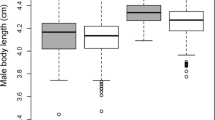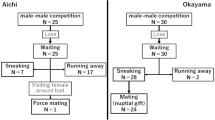Summary
Male sand lizards (Lacerta agilis) are polygynous and guard individual females for several hours to days after copulation. Even though the copulation itself only lasts 2–4 min, the total time that a male invests per female is considerably more and may constitute a substantial investment during a mating season. In such situations, when male copulation frequency is constrained, or when variation in female fecundity is high, mate choice by males may be adaptive. Large body size in female sand lizards is correlated with higher fecundity. In choice experiments performed in the laboratory, male sand lizards preferred to court large females rather than small females. In addition, when there was little difference in size between the females in the experiment, the males visited the two females more often before they started to court the preferred female. The results from a field study during 1984 and 1987–1990 showed that females are non-aggressive, have small neighboring home ranges (c. 100 m2) and may share burrows and sites for thermoregulation. This means that females can be found close together and thus gives males the opportunity to choose a mate. Assortative mating with respect to size was observed in a natural population, as well as a limited number of direct choices of females by males. These results support the results of the choice experiment.
Similar content being viewed by others
References
Aleksiuk M, Gregory P (1974) Regulation of seasonal mating behavior in Thamnophis sirtalis parietalis. Copeia 1974:681–689
Bischoff W (1984) Lacerta agilis Linnaeus 1758 — Zauneidechse. In: Handbuch der Reptilien and Amphibien Europas 23–68
Bradbury J, Andersson M (eds) (1987) Sexual selection: testing the alternatives. (Dahlem Workshop report). Wiley, Chichester
Darwin C (1871) The descent of man and selection in relation to sex. Appleton, New York
Davies NB, Halliday TR (1977) Optimal mate selection in the toad Bufo bufo. Nature 269:56–58
Dewsbury DA (1982) Ejaculate cost and male choice. Am Nat 119:601–610
Gartska W, Camazine B, Crews D (1982) Interactions of behavior and physiology during the annual reproductive cycle of the red-sided garter snake Thamnophis sirtalis parietalis. Herpetologica 38:104–123
Gwynne DT (1982) Mate selection by female katydids (Orthoptera: Tettagoniidae, Conocephalus nigropleurum). Anim Behav 30:734–738
Houde A, Endler J (1990) Correlated evolution of female mating preferences and male color patterns in the guppy Poecilia reticulata. Science 248:1405–1508
Johnson L, Hubbell S (1984) Male choice — experimental demonstration in a brentid weevil. Behav Ecol Sociobiol 15:183–188
Kitzler G (1941) Die Paarungsbiologie einiger Eidechsen. Z Tierpsychol 4:335–402
Nakatsuru K, Kramer D (1982) Is sperm cheap? Limited male fertility and female choice in the lemon tetra (Pisces, Characidae). Science 216:753–755
Olsson M (1984) Spacing patterns and social systems in the sand lizard Lacerta agilis. Honors thesis, University of Göteborg, Sweden
Olsson M (1986) Ecology of a Swedish population of the sand lizard Lacerta agilis — a preliminary report. Mertensiella 1: 86–91
Olsson M (1992 a) Contest success in relation to size and residency in the sand lizard. Anim Behav 44:386–388
Olsson M (1992 b) Sexual selection and reproductive strategies in the sand lizard, Lacerta agilis. Dissertation, University of Göteborg, Sweden
Sargent RC, Gross MR, Van den Berghe EP (1986) Male mate choice in fishes. Anim Behav 34:545–550
Schwagmweyer LP, Parker GA (1990) Male mate choice as predicted by sperm competition in thirteen-lined ground squirrels. Nature 348:62–64
Simon C (1983) A review of lizard chemoreception. In: Huey RB, Pianka ER, Schoener TW (eds) Lizard ecology — studies of a model organism. Harvard University Press
Stamps J (1983) Sexual selection dimorphism and territoriality. In: Huey RB, Pianka ER, Schoener TW (eds) Lizard Ecology — studies of a model organism. Harvard University Press, Cambridge, Mass
Trivers R (1972) Parental investment and sexual selection. In: Campbell B (ed) Sexual selection and the descent of man. Aldine, Chicago
Verrell P (1985) Male mate choice for larger, more fecund females in the red-spotted newt Notophthalmus viridescens: how is size assessed? Herpetologica 41:382–386
Watt WB, Carter PA, Donohue K (1986) Females' choice of ‘good genotypes’ as mates is promoted by an insect mating system. Science 233:1187–1190
Author information
Authors and Affiliations
Rights and permissions
About this article
Cite this article
Olsson, M. Male preference for large females and assortative mating for body size in the sand lizard (Lacerta agilis). Behav Ecol Sociobiol 32, 337–341 (1993). https://doi.org/10.1007/BF00183789
Received:
Accepted:
Issue Date:
DOI: https://doi.org/10.1007/BF00183789




